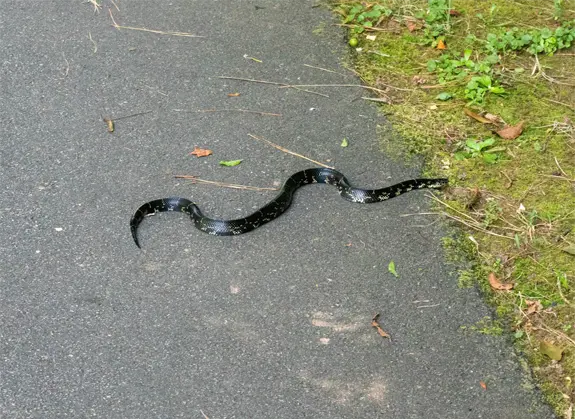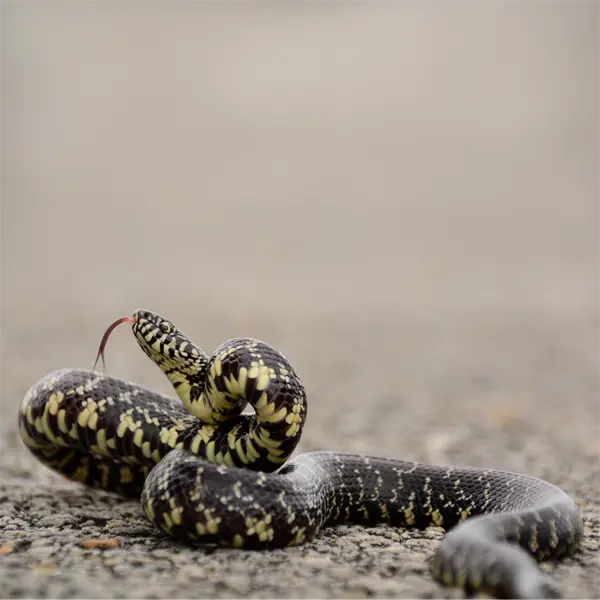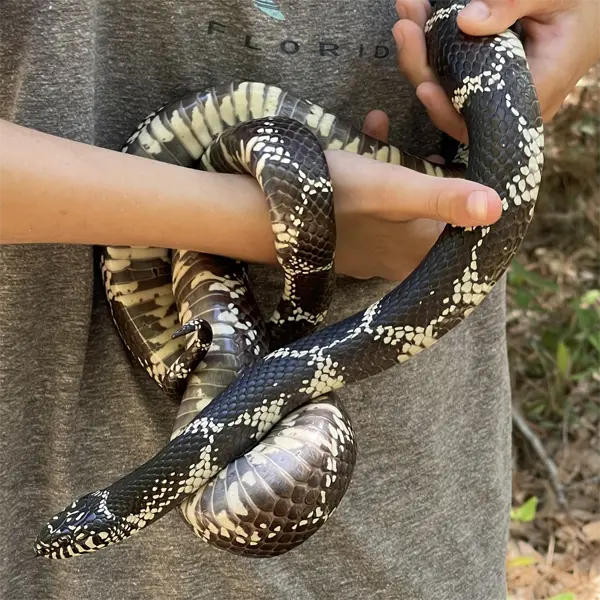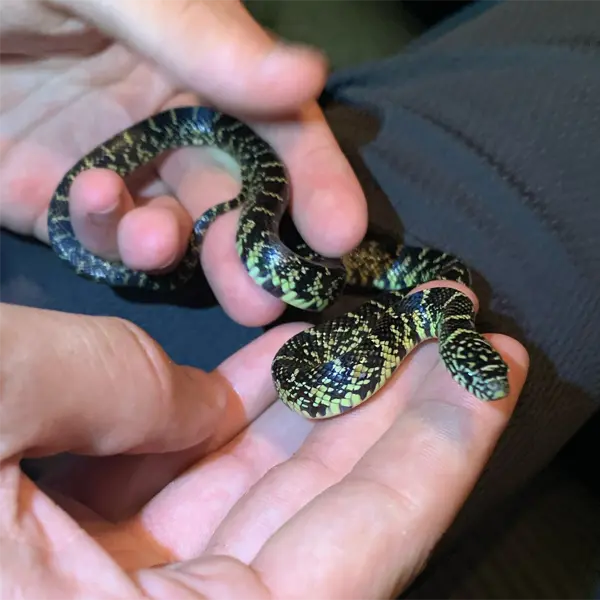Eastern Kingsnake
- Scientific Name
- Lampropeltis getula getula
- Also Known As
- Florida Kingsnake, Common Kingsnake
- Range
- All of Florida
- Diet
- Small Vertabrates, Snakes, Eggs
- Life Expectancy
- 10 - 15 Years
Quick Links
The Eastern Kingsnake in Central Florida
The eastern kingsnake (Lampropeltis getula getula) is a nonvenomous colubrid species indigenous to the southeastern United States, including the central Florida peninsula. This comprehensive guide provides detailed identification tips, biology facts, and prevention methods for eastern kingsnakes inhabiting central Florida.
Read on to learn eastern kingsnake appearance, habits, reproduction, ideal habitat conditions, diet, health considerations, and professional removal options if encountered on your property.
Appearance and Identification
Eastern kingsnakes can be identified by their distinct color patterns and scalation at both juvenile and adult life stages
Eastern kingsnakes can be confused with the scarlet kingsnake and milksnake. However, the eastern kingsnake lacks the vibrant red bands of the scarlet kingsnake and the distinctive red blotches between black bands seen in the milksnake.
Maturation Rate
Eastern kingsnake hatchlings begin feeding within their first week of life. They shed frequently as juveniles, allowing rapid growth. Kingsnakes attain full reproductive maturity by age 2 to 3 years in Florida.
Habits and Behavior
Eastern kingsnakes are primarily diurnal, active during the day and early evening. They are terrestrial, residing mainly on the ground surface rather than climbing shrubs or trees. Kingsnakes frequent open habitats with sandy soil for burrowing including pine flatwoods, scrubby flatwoods, upland hardwood hammocks, and human-altered environments.
Eastern kingsnakes are solitary and spend much of their time sheltered underground or beneath surface debris. During warm days, they emerge to bask or search for prey. If threatened, eastern kingsnakes may rapidly vibrate their tails as a defensive tactic before fleeing. They are non-venomous but may bite or excrete musk if handled.
Reproduction and Lifespan
Eastern kingsnakes breed from March through May in central Florida. Males engage in ritual combat for receptive females. After copulation, females lay clutches of 5 to 20 leathery eggs in burrows, stumps, under logs, or other protected sites. Kingsnake eggs incubate for 50 to 80 days before hatching from July to October.
Hatchlings grow rapidly and reach sexual maturity within 2 to 3 years. Captive longevity exceeds 20 years but wild eastern kingsnakes average 10 to 15 years.
Ideal Habitat and Range
Central Florida’s climate is ideal habitat for eastern kingsnakes. Average annual temperatures range from the low 70sF (22C) in northern counties to the upper 70sF (25C) in southern regions. Summer brings highs in the 90sF (30sC) while winter lows remain above freezing.
Abundant rainfall up to 60 inches (1500 mm) annually supports dense vegetation, providing food sources and shelter. Open pinewoods, oak hammocks, and scrub offer loose, sandy soil for burrowing and thermoregulation. Urban areas, farms, and parks also provide habitat. The mild winters, warm summers, and abundant prey allow eastern kingsnakes to be active year-round in central Florida.
Diet and Feeding
Eastern kingsnakes are opportunistic feeders on small vertebrates and their eggs. Hatchlings start on soft-bodied prey like earthworms and salamanders before shifting to small rodents, birds, lizards, and snake eggs as adults. Kingsnakes locate prey using chemical cues and constrict prey to kill it before swallowing the animal head first. Their diet consists of:
- Small rodents – mice, juvenile rats, voles, etc.
- Lizards – skinks, anoles, geckos
- Bird eggs and nestlings
- Snakes – even venomous species
- Amphibians – frogs, salamanders
- Invertebrates – caterpillars, beetles, earthworms
Kingsnakes play an important role as rodent and venomous snake predators in Florida ecosystems. They are immune to native pitviper venom and readily consume venomous species including eastern diamondback rattlesnakes, cottonmouths, and copperheads.

Photo 87844800 © randytoad, CC BY-ND

Common Health Risks
Eastern kingsnakes pose minimal health risks to humans as nonvenomous snakes. However, a few considerations include:
- Bites – Kingsnakes may bite if threatened but are not venomous. Bites should be cleaned to avoid infection.
- Musk – Kingsnakes can release a foul musk from their cloaca when handled. This can cause skin and eye irritation.
- Zoonotic bacteria – Salmonella and other bacteria may be present in feces and oral secretions. Prevent contact and thoroughly wash hands after handling snakes.
Overall, eastern kingsnakes are not dangerous if left undisturbed in the wild. Their presence helps control rodent and venomous snake populations.
Preventing Eastern Kingsnakes
The best approach for avoiding conflicts with eastern kingsnakes is tolerance. As nonvenomous snakes, kingsnakes pose minimal risks if left undisturbed. However, use these prevention tips if kingsnakes are unwanted near your home:
- Seal any openings into the foundation greater than 1/4 inch (0.6 cm) across. This excludes snakes from entering the structure.
- Trim vegetation and debris around the foundation to reduce shelter and prey, discouraging kingsnake activity.
- Remove rock piles, boards, tree stumps, and any other habitat “refuges” near the home.
- Limit food sources like rodents and frogs by cleaning up spilled pet food and installing rodent-proof garbage receptacles.
- Install wildlife fencing or screens around ponds and gardens to exclude snakes.
Trapping and relocation of wayward kingsnakes should only be conducted by trained wildlife professionals. Avoid using lethal control methods – kingsnakes are important natural pest controllers.
Eastern Kingsnakes in Central Florida – Conclusion
Eastern kingsnakes are native snake species uniquely adapted to central Florida’s warm, humid environment. They play integral roles in controlling rodent and venomous reptile populations. Kingsnakes primarily pose no threats to humans if given space and allowed to fulfill their ecological niche. By understanding kingsnake identification, habits, habitat, and prevention, conflicts can be avoided. Overall, eastern kingsnakes are beneficial components of Florida ecosystems that should be conserved.







